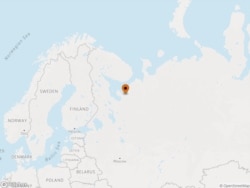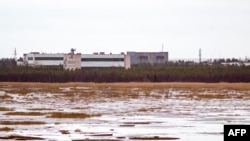A Norwegian research institute has walked back earlier findings that there may have been two explosions at a Russian naval test site earlier this month, an incident that killed at least five people and caused a temporary spike in radiation levels.
In a statement on August 27, Norsar said that additional analysis of its seismic and low-frequency records from August 8 showed that the second event detected by its monitors may not have come from the Nyonoksa test range, on the White Sea.
“Further analysis of the event with additional seismic data indicate that the event also may stem from mining activity in Finland,” the institute said.
The institute’s findings add to the mix of evidence that observers have scrambled to gather in an effort to explain what happened at the test site on August 8.
Russian officials have given scant and contradictory information about what exploded during what President Vladimir Putin has said was a test of a weapons system.
The state-run atomic energy company Rosatom said the test involved an “isotope source of a liquid-fueled propulsion unit.”

On August 26, Russia’s state weather agency, Rosgidromet, said that in the hours and days after the explosion, a cloud of inert radioactive gases formed as a result of a decay of the isotopes. That was the cause, it said, of the brief spike in radiation in Severodvinsk, a major shipbuilding port located not far from the Nyonoksa test range.
The agency said the isotopes detected included barium, strontium, and lanthanum.
Nils Bohmer, who works at a Norwegian government agency that studies nuclear waste disposal, said Rosgidromet’s findings were an indication that a nuclear reactor may have exploded.
"The presence of decay products like barium and strontium is coming from a nuclear chain reaction. It is proof that it was a nuclear reactor that exploded," Bohmer told The Barents Observer newspaper.
Bohmer’s theory has not been confirmed by officials.
In the hours after the accident, some residents of Severodvinsk bought up iodine drops in city pharmacies. Iodine is often taken to protect the thyroid gland from some types of radiation.
Russian officials have repeatedly downplayed any danger of contamination for residents of Nyonoksa, Severodvinsk, or the regional center of Arkhangelsk.
“I'm absolutely positive, and I have every reason to affirm the absence of any factors endangering the health and lives of people in the Arkhangelsk region, both on August 8 and at the present," Interfax quoted regional Governor Igor Orlov as saying on August 26.
Some U.S. officials have said they believe radioactive elements were involved in the accident, and some analysts have focused attention on a nuclear-powered cruise missile that Putin announced was under development last year.
But a growing number of other analysts have said it’s more likely that the radiation that was released came from another related component or device that was destroyed in the explosion.
Dvinsk Bay, where the three communities are located, was ordered closed for swimming and fishing, due to the presence of toxic rocket fuel.















